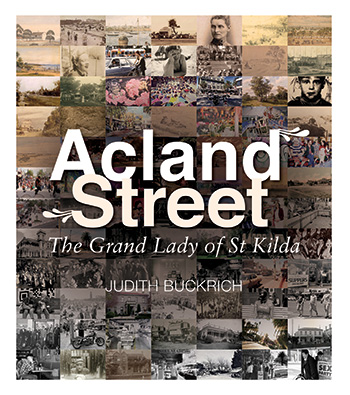Acland Street: the Grand Lady of St Kilda


The lavishly-illustrated, hardcover book explores the history of Acland Street since it became St Kilda’s first named street in 1842, taking its name from Thomas Dyce Acland, the owner of the schooner Lady of St Kilda which gave its name to the suburb.
The fortunes of Acland Street have ebbed and waned along with St Kilda’s. They grew rapidly during the Gold Rushes and the boom that followed, dipped in the 1890s’ depression, rose again after World War 1, fell catastrophically in the Great Depression, and started to climb again in the 1980s. It’s been home to the wealthy and the poor, to Jews escaping Nazism, and to a motley of musicians, artists, gays, sex workers and radicals. It is a place where the rich and down-and-out, respectable and disreputable, highbrow and lowbrow, have always jostled for space and dominance.
Acland Street was at the forefront of cultural innovation for much of the twentieth century, Dr Buckrich said. Because of its place as part of Melbourne’s centre of entertainment, and its functions, despite its short length, as a conduit between such different micro-culture as Fitzroy Street and Barkly Street, and crossed by the Esplanade and Carlisle Street, it has always been vibrant, always changing. In 1915, the Elite Skating Rink and Biograph on the corner Barkly Street was converted into the Palais Cinema, seating 2000. It ushered in a new era of cinema-going.
Acland Street has been a subversive presence in the music scene from the 1930s when jazz musicians jammed late nights at the Galleon coffee lounge. At the Plaza Café on the corner of Barkly Street, you could catch blues singer Molly Byron, with her short cropped curly black hair and trousers playing trumpet with her all-women jazz band. In the mid-fifties when conservatism otherwise reigned, German impresario, Horst Liepolt set up Jazz Centre 44, one of Australia’s most innovative jazz clubs. Liepolt paid £5 a week to rent the upstairs space at Katarina’s Café, the quaint building on the corner of the Esplanade, now McDonald’s. On Sunday afternoons, Jazz Centre 44 featured many important musicians of the time such as Stewie Speer, Brian Brown, Alan Lee, and the Melbourne New Orleans Jazz Band.
Less than a 100 metres away were the Telefil Recording Studios set up in 1954 at St Kilda Memorial Hall (now Memo Hall) by pioneering music producer, Bill Armstrong. As a youngster, Bill had hung around the Galleon Café and other music haunts to listen to jazz. In 1956, he was part of the recording team for the Melbourne Olympics. At Telefil he and his team, which included a band, recorded jingles and segments for TV shows like Sunnyside Up and the Go Show. It was at the Telefil studios that Normie Rowe recorded his 1965 hit, It Ain’t Necessarily So, from the American musical Porgy and Bess. In 1965 Bill left Acland Street to establish studios in South Melbourne which continue to this day.
From the time the revamped Prince of Wales reopened in its full art deco splendour on the corner of Fitzroy Street in 1937, it became a magnet for the gay community, many of whom lived in local boarding houses and flats. A section of the front bar became a favourite hangout and still is. In 1977 the famous Pokeys Drag Shows were started in the Prince Band Room on Sunday nights by Jan Hillier and Doug Lucas. On Monday nights there was Penny’s for the lesbians. From the late seventies, the Band Room became one of the major pub music venues for the alternative music scene, especially punk rock and New Wave bands. Bands which made their names there included Dave Graney and the Coral Snakes, the Black-eyed Susans, the Cosmic Psychos and Sonic Youth. Live music continues to be played at the Prince and other venues including Memo Hall and the Vineyard.
The eighties saw a cultural renaissance in Acland Street with the opening of Theatre Works in the old Christ Church Parish Hall and establishment of Linden Gallery, formerly the home of the Michaelises, the influential Jewish family who built it in 1857. Linden also became home to Women in Film and Television and the Koori Cultural Project.
Acland Street has a special place in this city’s heart – and its collective memory. So many of the hundreds of people I have met and corresponded with over the course of writing the history love Acland Street with a passion that I have never heard expressed for any other place.